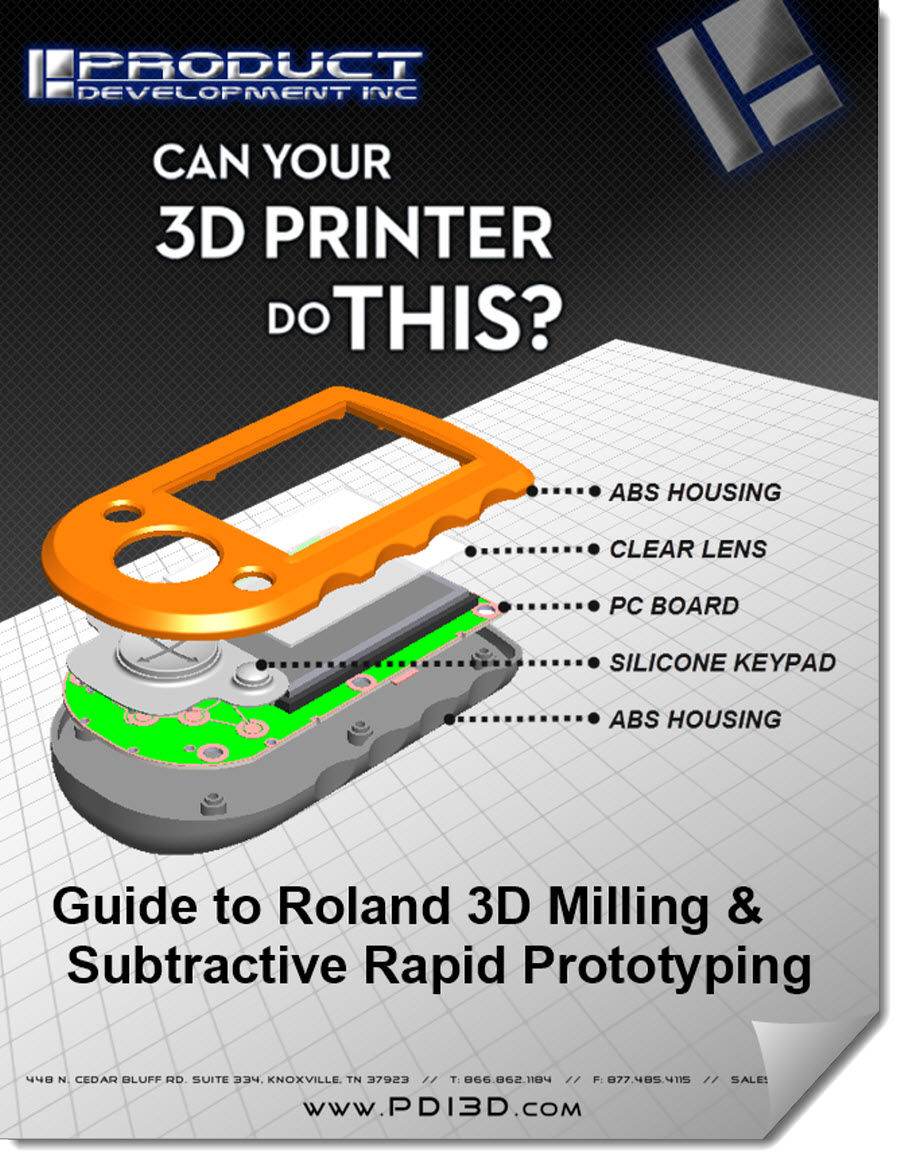Check it Out: Can Your 3D Printer Do This?
Latest News
April 9, 2013
 |
Additive manufacturing is de rigueur these days. But it’s not the only game in town. Milling, aka SRP (subtractive rapid prototyping), can do a lot of things that you simply cannot do or do as well with 3D printing. Today’s Check It Out explains how, why, and a whole lot more.
“Can Your 3D Printer Do This?” carries the subtitle a “Guide to Roland 3D Milling & Subtractive Rapid Prototyping.” But it’s not from Roland DGA Corp. It’s a Roland booklet extended and repurposed by a company called Product Development Inc. (PDI), an employee-owned VAR based out of Knoxville. And, while PDI sells, services, and trains you and your engineers to use Roland SRP equipment, it also offers a line of 3D printers from a leading manufacturer. Ergo, no ax to grind here, and that makes parts of this 10-page PDF a little gem.
This paper wastes no time getting going. The first two pages are a rapid rundown of Roland’s MDX line of SRP systems—material choices, part build sizes, options, prices, beauty shots. Benefits such as smooth surface finish, tight tolerances, industry standard tooling, low cost of ownership, and bundled CAM software (no G-code programming required) are listed in a chart. So far, that’s what you’d expect.
But then it pivots to a discussion of fit, finish, and functionality. This section compares the same part made by an SRP unit and a 3D printer using similar polymers. The highlight here is a set of high-magnification images showing the differences between tolerances, surface finishes, and deviations. It’s well done.
Next comes a quick tour of materials. All Roland SRP gear works with foams, plastics, wax, and wood. The two top-end units can also work with light metals such as brass. Again, this section is well illustrated with images of parts you’d brag about.
Then it’s pièce de résistance #1: Advanced applications. Now, a key part of what PDI does is extend the Roland MDX milling line with its exclusive set of accessories for PC board prototyping, rotary and diamond drag engraving, 3D scanning, and a video measuring. Let’s look at the last two. The video measurement system lets you install a camera into your MDX’s spindle then, with a little software assist, you can measure, inspect, and reverse engineer a part mounted on the machine table. For 3D scanning, PDI has a small touch probe for collecting points. It’s said to offer a 0.002-in. scanning pitch, which means you should be able to collect really small details.
Pièce de résistance #2: Money. This two-part section begins with our old pal ROI (return on investment). This delivers a good baseline for your own ROI studies. Demo SRP parts are deconstructed into their constituent dollar amounts such as material costs, time to build, and labor overhead. Comparative pricing for 3D printed versions and their costs were developed with data from an outside service bureau.
Finally, it’s cost of ownership. One-by-one, Roland’s MDX line of SRP systems is listed in a chart that shows hard dollar comparisons with an equivalent 3D printer. Expenditures equated include system price, warranty, options, miscellaneous annual fees, and materials over a 5-year period. The paper then wraps with a discussion of the supplied CAM software (seems neat) and a testimonial.
The money talk section of this paper interested me and should anyone with an eye on the ledger. But what most intrigued me were the advanced applications. This is the stuff of innovation. It seems that PDI’s extensions to the Roland MDX line of SRP systems offer a swift path to nimbleness—especially for the small shop and department needing a competitive edge, but with limited funds for new equipment. Download “Can Your 3D Printer Do This?” from the link over there and see for yourself.
Thanks, Pal. – Lockwood
Anthony J. Lockwood
Editor at Large, Desktop Engineering
Can Your 3D Printer Do This - Guide to Roland 3D Milling & Subtractive Rapid Prototyping
Subscribe to our FREE magazine, FREE email newsletters or both!
Latest News
About the Author
Anthony J. Lockwood is Digital Engineering’s founding editor. He is now retired. Contact him via [email protected].
Follow DE





